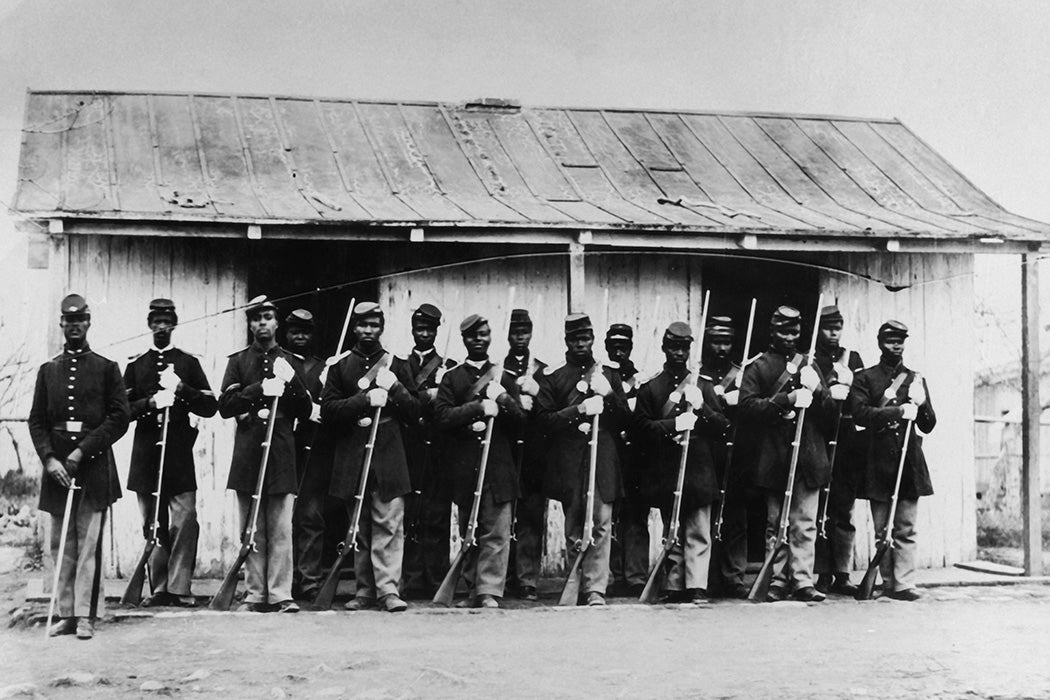More than three hundred thousand soldiers deserted their posts during the American Civil War. The Confederate forces saw a greater overall percentage of desertions, the Union a greater overall number. Soldiers left their terms of service early for a variety of reasons, including the pecuniary: some soldiers became “bounty” men, deserting and then reenlisting elsewhere for the cash bonuses offered to recruits.
Historian Jonathan Lande explores why “Colored Troops,” as they were then formally called, deserted.
“Experiencing freedom for the first time, many black soldiers discovered the discipline and racism of the army reminiscent of bondage and reacted angrily. Sometimes they rebelled as runaways had during enslavement—they ran. They deserted the army and its injustices to forge a freedom worth living.”
According to Union Army records, 12,400 of the 200,000-plus Union deserters were Black Americans. Around 180,000 Black men joined the Union Army during the war. 146,000 of these men were from slave states, former slaves who had emancipated themselves and moved towards Union forces.
The Emancipation Proclamation of January 1, 1863, sanctioned the use of Black soldiers by the Union. This was, at the time, of great political controversy because many whites in the Border states as well as in the North feared arming Blacks would inspire slave rebellions and attacks on whites.
The great majority of African American soldiers “adjusted to military life and proved courageous,” writes Lande, “but for many black men military service felt nearer to unfreedom than freedom.” Military service was decidedly “not emancipatory.” It was, in fact, rigorously coercive. The contract of enlistment signaled, in the minds of the white officers of the U.S. Colored Troops (USCT), consent “to the conditions of military life, extending to the most draconian forms of army discipline.” Former slaves, too familiar with draconian forms of plantation discipline, sometimes had other ideas.
Some questioned their all-white leadership and said that slave masters had been replaced by “Union masters.” Others protested the lower wages they were paid compared to white soldiers, after being promised the same amount. Others decided their families, living in what we would now call refugee camps, needed them more than the army did: starving children were a stronger draw than the harshness of military discipline.
But “under military law, the complexity of resistance was flattened into desertion.” Deserters were treated harshly if they were captured, and racism meant Black deserters could be treated more harshly than white ones—a tendency repeated in America’s wars in the twentieth century.
Lande notes that most USCT officers were chosen for their abolitionist sympathies. Abolitionists were not necessarily free of racism. Many thought of abolition as a “matter of liberalized labor, not social revolution.” They assumed that contractual wage labor would replace slavery, in the Army as well as elsewhere in the restored Union. Breaking the contract meant a court-martial, which was, of course, somewhat different from being fired.
Desertion during the Civil War resulted in various punitive sentences. Not uncommon was a drumming out of camp, which was essentially a dishonorable discharge in public, to the tune of “The Rogue’s March.” Drumming out could include “one side of the head shaved as a mark of shame.”
Weekly Newsletter
The most extreme sentence for desertion was death. Lande notes that the Army invited two photographers to the June 1864 execution-by-hanging of Private William Johnson, who admitted he’d deserted his unit, the 23rd USCT. The execution was in “plain view of Union and Confederate lines” as shooting across those lines paused for the occasion.
The hanging was of course meant to be an example—one perhaps taken differently by those who found that military service did not “mean existential fulfillment or a place for future black uplift.”







